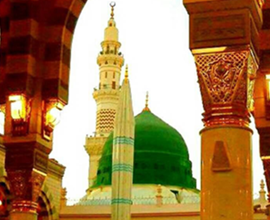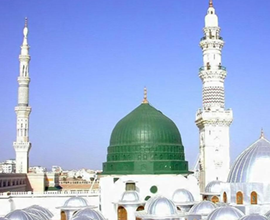Umrah is a great act of worship for every Muslim once in his life. The rewards and virtues of performing Umrah are many; the Holy Prophet Saying mentioned is a Ahadith: Performing Umrah in the month of Ramadan has a special significance, the Holy Prophet Saying said: “To perform one Umrah in the month of Ramadhan is equal in reward of a Hajj in my company”.
Umrah can be performed at anytime of the year (although Umrah visas are issued from Rabi al-Awwal to Ramadan only) and usually takes about 3 hours to perform under normal circumstances. During the low season (i.e., other than Ramadan and Hajj) Makkah and Madinah are relatively quiet, allowing you to carry out your worship in a relaxed manner. Umrah during Ramadan is an extra special experience, as there is a unique atmosphere in the haramayn, particularly at iftar time and during salaat al tarhwee and qiyam al layl prayers.
Ihraam
-
It is preferable to take a bath before assuming Ihram
-
Men are to wear:
- Clothes that have not been specifically made to fit the shape of the body. This normally consists of two white sheets; one is wrapped around the waist whilst the other is used to cover the top half of the body.
- Sandals or any other footwear may be worn that does not cover the ankle.
- It is not permissible to wear a hat or turban
-
Women are to wear their normal dress – with the exception of gloves and niqaab (the face covering that is tied around the head, however this should not touch there face).
-
You may put on the clothing of Ihram before you reach the Meeqat.
-
It is permissible for the men to apply perfume to their body before they make intention but not after.
-
Upon reaching the Meeqat you make intention for Umrah by saying the following word
(Allaahumma labbayka Umrah)
“Here I am O Allah making Umrah “
“Whoever performs Umrah in Ramadan, receives the reward like one who performs Hajj with me.”
“Between one Umrah and another is an expiation of sins”.
-
For those people arriving by plane to Jeddah, the Meeqat is passed shortly before landing (20-30 mins). It is imperative that one does not pass the Meeqat without assuming Ihram.
-
It is preferable to say the Talbiyyah in a loud voice from this point onwards:
(Labbayk allahumma labbayk, Labbayka laa shareeka laka labbayk, Innal hamda wan-ni ‘mata laka wal mulk laa shareeka lak)
“Here I am O Allah, here I am – there is no partner for You – here I am. Verily all praise is for You; every bounty is from You, and all dominion is Yours – You have no partner.”
-
Talbiyyah is to be stopped when you see the houses of Makkah
Entering the Masjid al-Haraam
-
It is preferable to enter the Masjid from Baab Bani Shaibah. It is Sunnah to enter any Masjid (mosque) with the right foot first saying the following:
(Bissmillaah, wassalaatu was-Salaamu ‘alaa rasoolillaah, a ‘oodhubillaahil ‘adheem, wa biwajhihil kareem, wa sultaanihil qadeem, minash shaytaanir rajeem. Allahummaftahlee abwaaba rahmatik)
” In the name of Allah. Peace and blessing be upon the Messenger of Allah. I seek refuge in Allah the Great, in His honourable Face and in His Ancient Authority from the accursed satan. O Allah open for me the doors of Your Mercy.”
-
Upon seeing the Ka ‘bah you may raise your hands and make any supplication – one of the Companions of the Prophet [Umar] would say
(Allaahumma antas salaam, wa minkas salaam, fahayyinaa rabbanaa bis salaam)
“O Allah, Your are as-Salaam, and from You is Salaam and greet us our Lord with Salaam.”
Performing the Tawaaf
-
One must be in a state of wudoo (ablution) while performing Tawaaf.
-
One should go straight to the Black Stone and say:
(Allaahu Akbar)
“Allah is the Greatest.“
While facing it.
-
Then touch the Black Stone with your hand, kiss it and make sajdah upon it. If however this is not possible then touch it with your hand and kiss your hand. If even this is not possible then just point towards it with your right hand only (not kissing your hand) – this is to be done at the beginning of each circuit of Tawaaf.
-
Thus you begin your Tawaaf at the Black Stone, circling the ka ‘bah, with the ka ‘bah on your left. Each time you reach the Black Stone to begin your next circuit repeat points (13) and (14). Seven circuits are to be completed.
-
During the Tawaaf the man wears his Ihram under his right arm pit and over the left shoulder (with the right shoulder bare). The man completes the first three circuits walking quickly with boldness (but not running).
-
Each time one passes the Yemeni corner of the Ka’aba (this is the corner before the corner of the Black Stone) it is preferable to touch it with ones hand, if this is not possible due to the crowds then one is not to point towards it.
-
The following supplication should be recited between the Yemeni corner and the Black Stone
(Rabbanaa aatinaafid dunyaa hasanatan wafil aakhirata hasanatan wa qinaa adhaaban naar)
” Our Lord! Give us good in this world and good in the Hereafter, and protect us from the punishment of the Fire.”
-
There are no particular du ‘aas (supplications) [apart from what is mentioned above] to be recited during Tawaaf- therefore one may recite the Qur’an, or supplicate with any other du ‘aa from the Sunnah or from ones heart in any language.
-
One may cling to the area between the Black Stone and the door of the Ka ‘bah and supplicate.
After the Tawaaf
-
After the Tawaaf one should cover both of his shoulders and proceed to the Station of Ibraheem (Maqaam Ibraheem) and recite:
(wattakhidhoo mim maqaami ibraaheema musalla)
“And take the station of Ibraheem as a place of Prayer.”
-
One should offer a two rak’aat prayer with the Station of Ibraheem between oneself and the ka ‘bah. It is preferable to recite Soorah Kaafiroon in the first rak’ah and Soorah Ikhlaas in the second rak’ah.
-
Be mindful not to walk in front of anyone praying nor allow any-one to walk in front of yourself.
-
Next proceed to Zam-Zam and drink the water of zam-zam and one should also pour it over ones head.
-
“O ALLAH! I ask you for beneficial knowledge for abudnace of sustenance and cure from all maladies.“
-
Return to the black stone and touch it saying:
(Allaahu Akbar)
“Allah is the greatest.”
SA’EE
-
The next stage is to go to Safa. Upon approaching the foot of Safa the following should be recited:
(Innas-safaa wal marwata min sha ‘aa-i rillaah. Faman hajjal baita awi’ tamara falaa junaaha alahi anyatawwafa bihimaa. Wa man tatawwa’a kharanfa innallaaha shaakirun ‘aleem)
” Verily, Safa and Marwa are from the symbols of Allah. So it is not a sin on him who performs Hajj or Umrah of the house (ka ‘bah) to compass them round. And whoever does good voluntarily, then verily, Allah is the All-Recogniser, the All-Knower.” and:
(Nabda ‘u bimaa bada allaahu bihi)
“We begin with what Allah began with.”
-
Then one is to climb unto Safa until the ka ‘bah is visible. Facing the Qiblah the following is to be said 3 times, and between each time one is to make one’s own supplication (in any language):
(Allahu akbar, Allahu akbar, Allahu akbar. Laa ilaaha illallahu wahdahu la shareekalahu, lahul mulku wala hul hamdu, wa huwa ‘alaa qulli shay in qadeer. Laa ilaha illallahu wahdahu, anjaza wa ‘dahu, wa nasara’abdahu, wa hazamal ahdhaaba wahdahu)
” Allah is the Greatest, Allah is the Greatest, Allah is the Greatest. None has the right to be worshipped except Allah alone, who has no partner. To Him belongs the dominion, to Him belongs all praise, and He has power over every-thing. He fulfilled His promise, gave victory to His servant, and defeated the confederates alone.”
-
Then descend and go towards Marwa, running between the fluorescent green lights, upon reaching Marwa one is to climb upon it and repeat the same procedure as when ascending Safa (see point 27). This completes one circuit. Then one continues back to Safa and repeats point 27 – thus completing two circuits.
-
There are no particular supplications to be recited between Safa and Marwa.
-
Seven circuits are to be completed ending the last one on Marwa.
It is Mustahab to perform two Rakaats Nafl after Sa’ee
-
Then one is to have his hair cut although shaving it is better. The women should shorten their hair by a finger-tips length from the end.
Your Umrah is now complete. Alhamdulillah.



